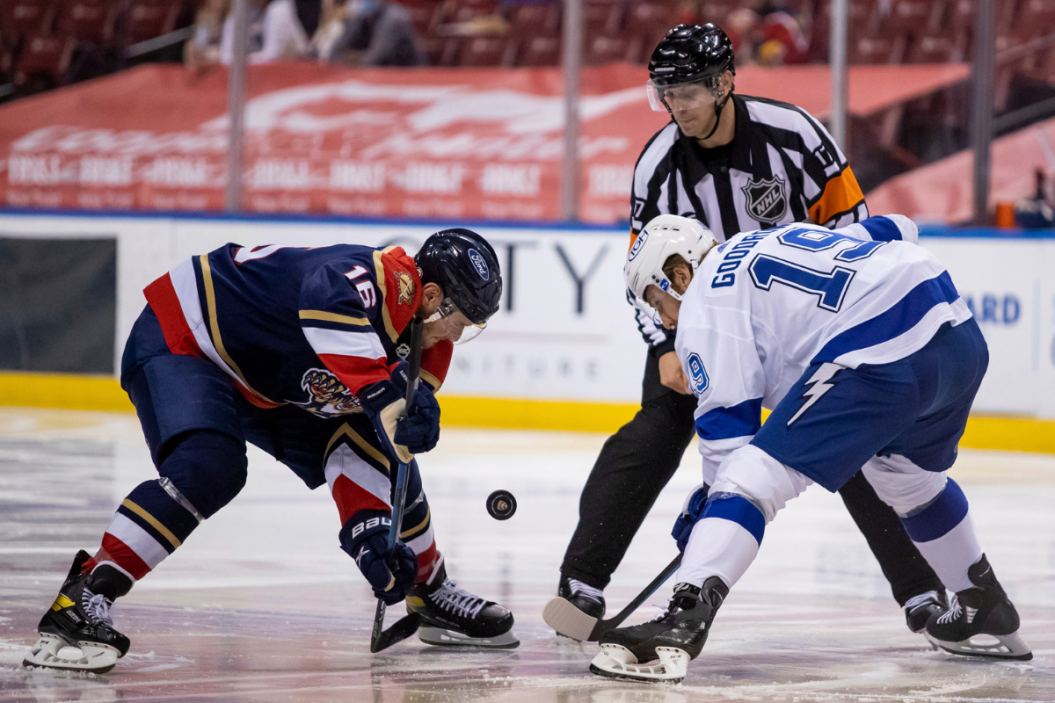There is a car dealership in Ontario called Racicot Chrysler. For many years, they aired lo-fi commercials during Hockey Night in Canada.
Videos by FanBuzz
In one of them, the patriarch of the family, Leo Racicot, is told that he has received a two-minute penalty for icing. Leo points out that icing, while an infraction in the NHL, is not a penalty, and is told by one of his sons that it is the way he does it.
Cut to a shot of Leo holding a puck icing it as if though it is a cupcake.
Anyway, this commercial isn't available anywhere online, but you can check out another Racicot Chrysler ad here for your edification and...let's go with "amusement."
If one were to slather frosting on a hockey puck, it would indeed yield a penalty, likely for delay of game. However, what is the actual icing rule? It's one of the most-common infractions in ice hockey, but how does one ice the puck?
We're going to focus on the NHL rule for icing, because rulings related to icing do differentiate depending on the league. Also, because the National Hockey League's approach to icing has changed extensively since it was introduced way back in 1937, purportedly (according to James Duplacey's book The Official Rules of Hockey) due to a 1931 game between the New York Americans and the Boston Bruins that featured the Bruins icing the puck with impunity a whopping 87 times in a goalless draw.
What is the Icing Rule in Hockey?
RELATED: How Much Money Do Zamboni Drivers Make?
Picture this: A team is in their defensive zone. One of the defensive players has the puck and shoots it all the way down the ice. This would, in theory, be a great way for a defenseman to alleviate pressure. However, it's not very fun for the viewer. Thus, the icing infraction comes into play.
If a defending player is on their side of center ice and shoots the puck over that center red line and the opposing team's goal line, the linesman will lift their arm to indicate a potential icing call.
Back in the day in the NHL, icing would only be called if the next person to touch the puck after it went over the red goal line was a defenseman or forward for the other team. This is called "touch icing." The problem was that, in order to try and avoid an icing call, a player from the defending team might go off on a mad dash — or rather a mad skate — toward the other end of the ice to try and nullify the icing.
This led, naturally, to an opposing player doing the same thing. This also led to many collisions and many players crashing into the end boards. Nasty injuries occasionally resulted from these clashes to nix an icing call.
Due to this, prior to the 2013-14 NHL season the league adopted hybrid icing. Now instead of racing to touch the puck, a player could clinch an icing simply by reaching the face-off dots first.
This keeps the aspect of racing to nullify icing into place, but lowers the risk of injury.
Some leagues, like American college hockey, have no-touch icing. There, icing is called simply as soon as the puck crosses the goal line.
How Teams Are Penalized for Icing the Puck
OK, so your team has committed icing. What happens now?
Play is stopped, and then that puck is brought all the way back to the offending team's end of the rink. Yes, icing the puck means a face off in your zone. Not only that, but the team that iced the puck is also not allowed to make a line change.
The premise is that a team will be stuck with tired players on the ice. In the last couple of seasons, the NHL has tweaked the icing penalties as well. A team that iced the puck is no longer allowed to call a timeout to give their players a breather. Also, if you commit icing, your opponent gets to choose which face-off circle will be used for the ensuing face off.
Ah, but there are ways in which icing can be waved off by the linesman. For example, if the first player to touch the puck for the opposing team is the goalie. Additionally, if a linesman feels a player on the other team is lolly-gagging to try and let a puck cross the goal line for icing they can wave it off under the premise the player could have gotten to the puck had their so chosen.
Then, there is the matter of a team being on a penalty kill. If your team is shorthanded, the icing rules go out the window. In fact, you are allowed to ice the puck until your heart is content if you are the shorthanded team.
However, not everybody is a fan of this. Some have argued that you should not be allowed to ice the puck on a penalty kill. The premise is that it will increase scoring, which makes this along the lines of people arguing that a power play should continue for the full length of the penalty, even if a goal is scored. There are always people out there trying to boost goal scoring in the NHL.
We're certainly glad a team can no longer dump the puck down the ice dozens of times legally like back in the 1930s. We're also glad that hybrid icing has dropped the number of icing-related injuries considerably.
If you want to delve into hockey rules further you can check out the NHL's official rule book. The section on icing begins on page 81. Happy reading!
